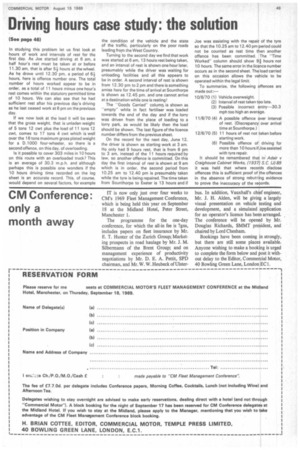Driving hours case study: the solution
Page 51

If you've noticed an error in this article please click here to report it so we can fix it.
(See page 46)
In studying this problem let us first look at hours of work and intervals of rest for the first day. As Joe started driving at 6 am, a half hour's rest must be taken at or before 11.30 am, that is after 5+ hours at the wheel. As he drove until 12.30 pm. a period of 61 hours, here is offence number one. The total number of hours worked appear to be in order, as a total of 11 hours minus one hour's rest comes within the statutory permitted time of 10 hours. We can also see that he had sufficient rest after his previous day's driving as he last ceased work at 6 pm on the previous day.
If we now look at the load it will be seen that the gross weight, that is unladen weight of 5 tons 12 cwt plus the load of 11 tons 12 cwt, comes to 17 tons 4 cwt which is well over the 16 tons maximum gross plated weight for a D.1000 four-wheeler, so there is a second offence, on this day, of overloading.
Is it possible to cover 303 miles in 10 hours on this route with an overloaded truck? This is an average of 30.3 m.p.h. and although perhaps this is possible one wonders if the 10 hours driving time recorded on the log sheet is an accurate record. This, of course, would depend on several factors, for example the condition of the vehicle and the state of the traffic, particularly on the poor roads leading from the West Country.
Turning to the second day we find that work was started at 6 am, 13 hours rest being taken, and an interval of rest is shown one hour later, presumably while the driver was waiting for unloading facilities and all this appears to be in order. A second interval of rest is shown from 12.30 pm to 2 pm and there is something amiss here for the time of arrival at Scunthorpe is shown as 12.45 pm. and one cannot arrive at a destination while one is resting!
The "Goods Carried" column is shown as "empty" while in fact fertiliser was loaded towards the end of the day and if the lorry was driven from the place of loading to a lorry park, as would be likely then the load should be shown. The last figure of the licence number differs from the previous sheet.
On the record for the next day, June 12, the driver is shown as starting work at 3 am. He only had 9 hours rest, that is from 6 pm to 3 am, instead of the 11 hours required by law, so another offence is committed. On this day the first interval of rest is shown at 9 am which is in order, the second period from 10.26 am to 12.40 pm is presumably taken while the tyre is being repaired. The time taken from Scunthorpe to Exeter is 13 hours and if Joe was assisting with the repair of the tyre so that the 10.25 am to 12.40 pm period could not be counted as rest time then another offence has been committed. The ''Time Worked" column should show 91 hours not 10 hours. The same error in the licence number occurs as in the second sheet. The load carried on this occasion allows the vehicle to be operated within the legal limit.
To summarize, the following offences are made out: 10/6/70 (1) Vehicle overweight.
(2) Interval of rest taken too late.
(3) Possible incorrect entry-30.3 mph too high an average.
11/6/70 (4) A possible offence over interval of rest. (Discrepancy over arrival time at Scunthorpe.)
12/6/70 (5) 11 hours of rest not taken before starting work.
(6) Possible offence of driving for more than 10 hours if Joe assisted with tyre repair.
It should be remembered that in Adair v Craighouse Cabinet Works, (1937) S.C. (J) 89 it was held that where records disclose offences this is sufficient proof of the offences in the absence of strong rebutting evidence to prove the inaccuracy of the records.






































































































